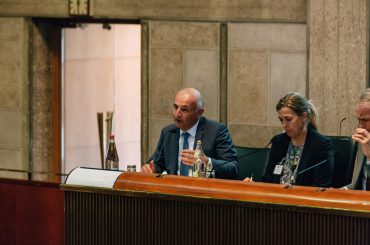Interview with Catherine de Wolf, Architect, environmental design specialist
Catherine De Wolf graduated with highest honors in civil engineering and architecture from the Vrije Universiteit Brussel and Université Libre de Bruxelles (French and Dutch-speaking dual degree), Belgium, and was granted the Victor Horta Award of Excellence. There, her research focused on how interactions between buildings, components and materials can support life-cycle design through sustainable management and reuse of materials; De Wolf’s work was applied to establish a renewed residential building typology for the city of Brussels.
De Wolf is involved in a number of research projects, such as the creation of an interactive database on carbon in buildings, while pursuing a PhD under the guidance of Professor John Ochsendorf, in the Building Technology lab at Massachusetts Institute of Technology, where she incorporates environmental design into the workflow of engineers and architects.
You created an innovative, eco-friendly platform; what is it exactly for and who can use it?
We need one single global method to cut carbon emissions today. I thus created a database which contains information on the amounts of materials used in and CO2 emitted by buildings worldwide. Engineers and architects can access the database through an interactive interface which allows them to compare their projects to thousands of other existing buildings.
Here is an example: my database helped compare two Olympic stadiums, namely the “Bird’s Nest” in Beijing and the London Olympic Stadium, and showed that the construction of the former emitted ten times more carbon than that of the latter.
My platform’s second feature is a computer-aided design tool which allows scientists, architects and engineers to work together with a view to reducing the environmental impact of their projects, while improving their functioning, aesthetics and structure. I hope that my contribution will foster an innovative approach to construction that preserves the creative freedom of architects and engineers.
You seem to be at the intersection of several fields: environmental design, architecture, engineering…
I studied architecture and engineering in Belgium before delving into building technology at MIT: my background and approach have therefore always been multidisciplinary. As for architecture, it is at the intersection of science and art, and is thus intrinsically interdisciplinary. Besides, each and every one of us is responsible, at our respective levels, for reducing our negative impacts on the environment.
It is necessary that all the people involved in design co-operate: engineers optimize the amounts of structural materials, while architects take the environment and the needs of residents into account and scientists and environmental designers contribute their expertise to help make the best decisions.
Can you tell us more about your approach?
We know that carbon emissions must decrease now if irreversible climate disasters are to be averted. Rather than focusing solely on optimizing a building’s future heating and lighting-related energy consumption, we must also cut construction-related emissions. This is why my project goes beyond “operational carbon” and encompasses the whole life-cycle of buildings, from materials extraction, production and transport to construction sites to construction and demolition as well as waste management, i.e. “intrinsic carbon”.
How did you end up working on these issues? What is your take on smart cities?
I wanted to make smart cities aware of the somewhat overlooked issue of intrinsic carbon. As much as environmental architecture has fostered significant innovations over the last decade, as yet little is known about the impact of materials and construction. As I have always been interested in life-cycle design, working on these issues was an obvious choice.
What do you hope for your sector in the coming years and in the longer term? What do you make of the changes brought about by ecology and new technologies?
I call for increasing awareness on the part of building designers, but also clients and entrepreneurs. Setting new targets will make it possible to reduce the environmental impact of the building sector.
This is not only about making buildings that use less or generate their own energy. It is also crucial to use local and natural materials with a view to constantly increase efficiency.
Besides, such alternative architectures can translate into extraordinary projects, such as bamboo or cardboard buildings successfully used among non-western societies.



